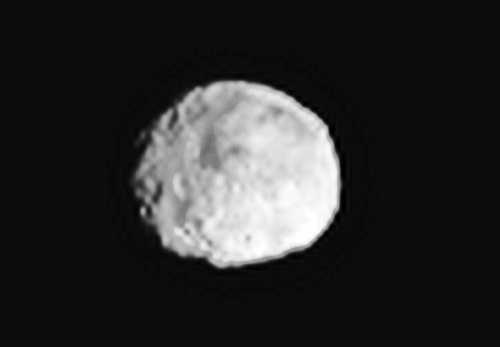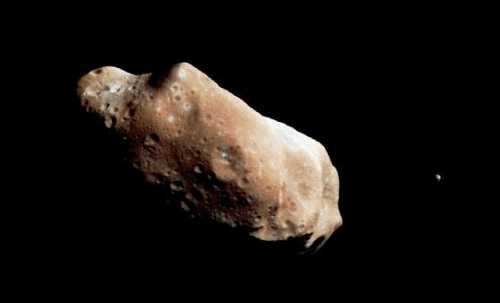
NASA's Dawn spacecraft is closing in on Vesta, and from now until the ion-powered spacecraft goes into orbit in mid-July, every picture of the giant asteroid will be the best one ever taken. What will researchers do with this unprecedented clarity?
“For starters,” said Dawn chief engineer Marc Rayman, “we're going to look for an asteroid moon.”
You might think of asteroids as isolated bodies tumbling alone through space, but it's entirely possible for these old “loners” to have companions.
Indeed, 19-mile-wide Ida, 90-mile-wide Pulcova, 103-mile-wide Kalliope and 135-mile-wide Eugenia each have a moon. And 175-mile-wide Sylvia has two moons.
Measuring 330 miles across, Vesta is much larger than these other examples, so a “Vesta moon” is entirely possible.
Where do such moons come from?
Rayman suggested one source: “When another large body collides with an asteroid, the resulting debris is sprayed into orbit around the asteroid and can gradually collapse to form a moon.”
Another possibility is “gravitational pinball”: A moon formed elsewhere in the asteroid belt might, through complicated gravitational interactions with various bodies, end up captured by the gravity of one of them.
Hubble and ground based telescopes have looked for Vesta moons before, and seen nothing. Dawn is about to be in position for a closer look. On Saturday, July 9, just one week before Dawn is set to go into orbit around Vesta, the moon hunt began. The cameras will begin taking images of the space surrounding the asteroid, looking for suspicious specks.
“If a moon is there, it will appear as a dot that moves around Vesta in successive images as opposed to remaining fixed, like background stars,” said Dawn Co-investigator Mark Sykes, who is also director of the Planetary Science Institute. “We'll be able to use short exposures to detect moons as small as 27 meters in diameter. If our longer exposures aren't washed out by the glare of nearby Vesta, we'll be able to detect moons only a few meters in diameter.”
While you won't see “find a moon” among the mission's science goals, a moon-sighting would be a nice feather in Dawn's cap. Not that it will need more feathers. The probe is already primed to build global maps and take detailed images of the asteroid's surface, reveal the fine points of its topography, and catalog the minerals and elements present there.
Besides, Dawn will become a moon itself when it enters orbit around Vesta. And the probe's motions as it circles will provide a lot of information about the rocky relic.
Sykes explains: “We'll use the spacecraft's radio signal to measure its motion around Vesta. This will give us a lot of detailed information about the asteroid's gravitational field. We'll learn about Vesta's mass and interior structure, including its core and potential mascons (lumpy concentrations of mass).”
As you read this, the spacecraft is gently thrusting closer to its target. And with the navigation images alone we're already watching a never-before-seen world grow ever larger and clearer.
“The pictures are beginning to reveal the surface of this battered, alien world,” said Rayman. “They're more than enough to tantalize us. We've been in flight for four years, we've been planning the mission for a decade, and people have been looking at Vesta in the night sky for two centuries. Now, finally, we're coming close up to it, and we'll be getting an intimate view of this place.”

This is not only the first time a spacecraft has visited this alien world, it's also the first time a spacecraft has visited a massive body we haven't approached previously. In the past, rocket ships have orbited Earth, the moon, Mars, Venus, Jupiter, Saturn and Mercury.
“In each case, flyby missions occurred first, providing a good estimate of the target's gravity along with information on other aspects of its physical environment, including whether any moons are present. This time we're much less certain what we'll find,” said Rayman.
At a recent press conference, NASA Planetary Science Deputy Director Jim Adams told reporters that Dawn will “paint a face on a world seen only as a 'fuzzy blob' up to now.”
What does Rayman think Vesta's face will look like?
“Wrinkled, ancient, wizened, with a tremendous amount of character that bears witness to some fascinating episodes in the solar system's history,” he said.
If a new moon is among the episodes, Rayman has a name in mind.
“How about 'Dawn'?”
Dauna Coulter works for the National Aeronautics and Space Administration.
Follow Lake County News on Twitter at http://twitter.com/LakeCoNews, on Tumblr at www.lakeconews.tumblr.com, on Facebook athttp://www.facebook.com/pages/Lake-County-News/143156775604?ref=mf and on YouTube athttp://www.youtube.com/user/LakeCoNews.